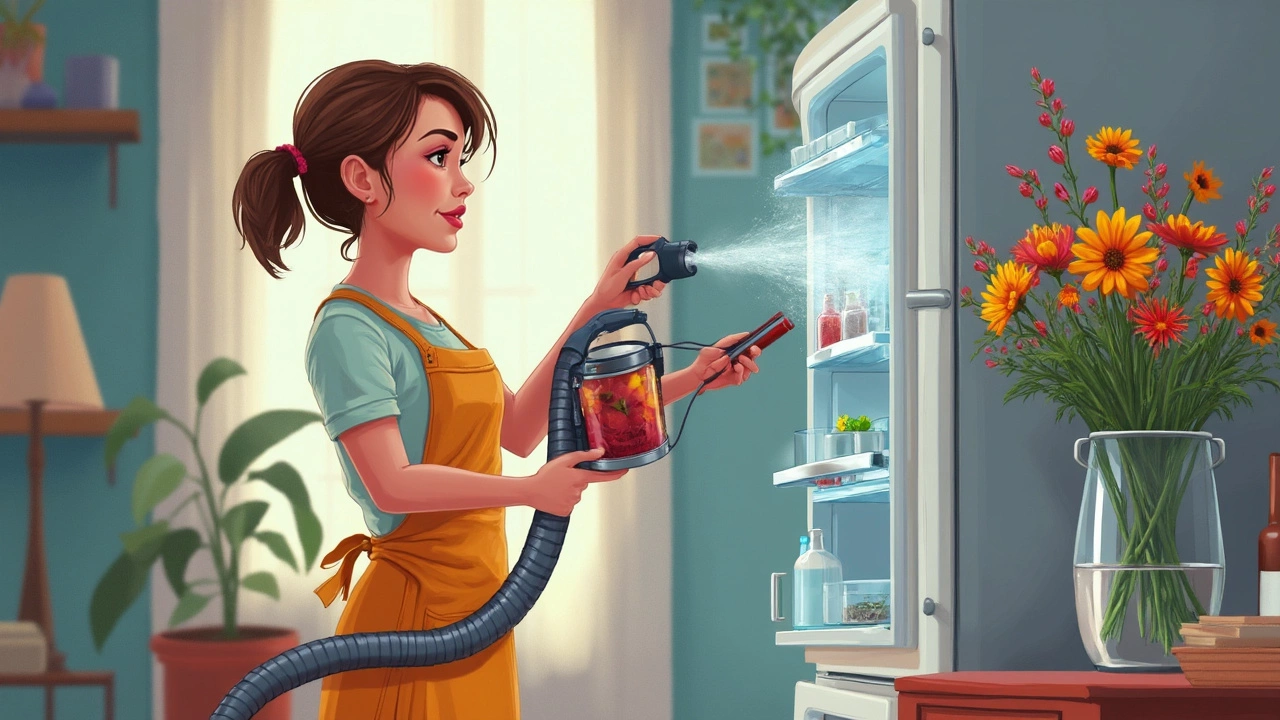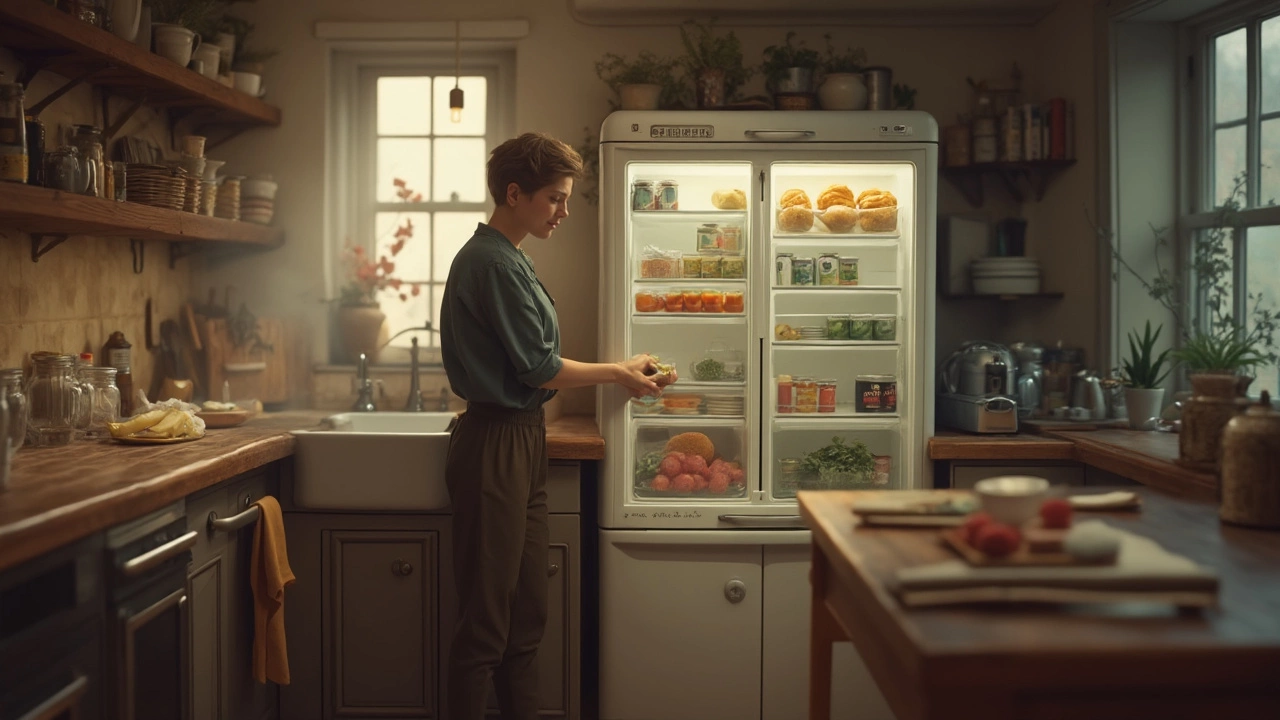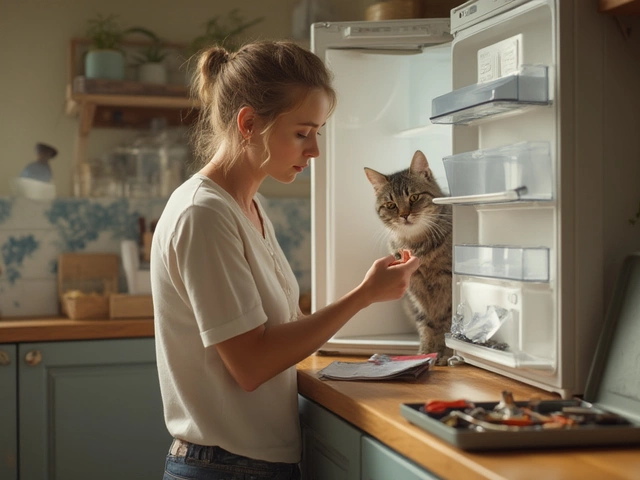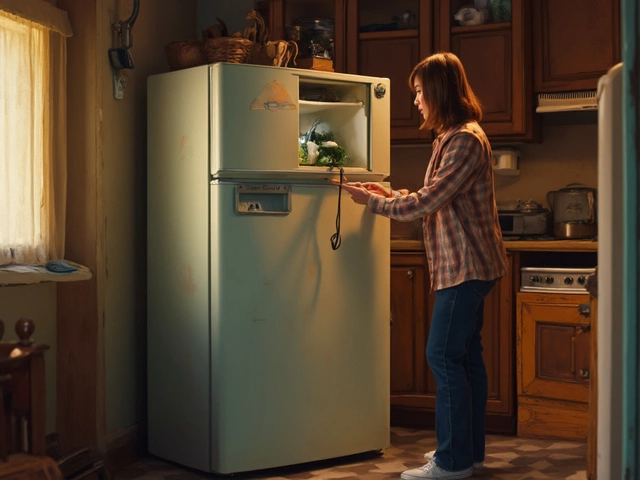So, your fridge is acting up and not keeping your food cold? That's pretty frustrating, but don't rush to call for expensive repairs just yet. Start by checking a few simple things that could be at the root of the problem.
First, double-check that the fridge is actually plugged in and getting power. It sounds obvious, but sometimes the cord can come loose, especially if the fridge has been moved around a bit. Next up, make sure the thermostat inside the fridge is set to the right temperature. Ideal settings are around 37°F for the fridge and 0°F for the freezer, so make any necessary adjustments.
If that doesn’t do the trick, take a look at the condenser coils, usually located at the back or underneath the fridge. These coils can get dusty and dirty, which makes it tough for the fridge to cool down properly. Grab a vacuum or a coil brush and give them a good cleaning.
- First Things to Check
- Condenser Coils Are Dirty
- Check Door Seals
- Thermostat and Temperature Control
- Listen for a Running Motor
- When to Call a Professional
First Things to Check
When your refrigerator stops cooling, it's tempting to panic. But hang on—there are a few initial steps you can take that might solve the problem without a repairman. Here’s where to start:
Power Supply
Before diving into complicated fixes, make sure your refrigerator is plugged in and getting power. You wouldn't believe how often the solution is just a loose plug or a tripped breaker. If your fridge light turns on when you open the door, you're good here.
Thermostat Settings
Your thermostat might have been accidentally adjusted. Check the temperature dial inside your fridge. For most fridges, the best setting is around 37°F and 0°F for the freezer. Adjust if necessary and see if it makes a difference in a couple of hours.
Vents and Airflow
Fans and vents inside the fridge circulate cold air; these can sometimes be blocked by food items. Check if big boxes or containers are placed right in front of any vents and move them out of the way. Good airflow is crucial for even cooling.
Condenser Coils Check
Condenser coils release the heat extracted from the refrigerator. If they’re covered with dust and grime, they can't do their job properly. To clean, unplug the fridge, and use a vacuum or coil brush to remove the dirt.
If these initial checks don’t resolve the issue, there might be deeper problems at play. But don’t worry—we’ve got more troubleshooting ahead!
Condenser Coils Are Dirty
The condenser coils in your fridge are crucial for keeping things cool. They help release the heat from inside your fridge, so if they're dirty, your fridge is not going to cool like it should. It's a common issue that’s pretty easy to fix.
Why Clean Coils Matter
When dust and grime build up on these coils, they can't efficiently release heat. That makes the fridge work overtime, increasing energy use and raising your electricity bills. Plus, it could lead to more wear and tear on the components.
How to Clean the Coils
- Unplug the Refrigerator: Safety first! Make sure to unplug the appliance before starting any cleaning.
- Locate the Coils: These are usually found either at the back of the fridge or underneath. You might need to move the fridge from the wall to access them.
- Vacuum and Brush: Use a vacuum with a hose attachment to suck up any loose dirt. Then, use a coil brush to reach between the coils. These are specially designed for this task and can be found at most hardware stores.
- Wipe Down: After brushing, use a damp cloth to wipe away any remaining dust or debris.
How Often Should You Do This?
It's a good habit to clean the coils every 6 months. If you've got pets, you might need to do it more often since fur can easily clog up the works.
Quick Fact
Did you know that cleaning the coils can improve your fridge's efficiency by up to 30%? Not only does this save energy, but it helps your fridge last longer too. Cleaner coils mean a cooler fridge and less stress on the parts that keep it running.
Taking a little time to clean those condenser coils can really pay off. Not only will your fridge cool more effectively, but you'll be saving money on energy bills. And hey, who doesn't want that?
Check Door Seals
Alright, let's talk about those door seals, which are officially called gaskets. They're the unsung heroes ensuring your fridge maintains the right temperature by keeping the cold air in and the warm air out. If they're not working right, your fridge might have trouble cooling, and no one wants that!
First, inspect the seals for any visible cracks or damage. Over time, they can wear out due to constant opening and closing. Fridge maintenance often involves just a simple checkup on the gaskets. If you spot damages, you might need replacements.
How to Test Your Door Seals
- Close the fridge door on a piece of paper or a dollar bill. If you can easily pull it out without any resistance, it's time to think about replacing the seal.
- Check for signs of mold or mildew, which not only looks gross but can also affect the seal's function. Clean any build-up with warm soapy water and a soft cloth.
Leaky door seals can make your fridge work overtime, which can mean a higher electricity bill and spoiled food.
Installing New Seals
- Once you've got the right fit, remove the old gasket by gently pulling it away from the door. It might be held in by screws or clips.
- Press the new gasket into place, starting from the corners and working your way around. Make sure it's snugly fitting to ensure no cool air escapes.
Installing a new fridge gasket isn't rocket science, but does require a little bit of patience. Doing it yourself can save you from hiring a pro while ensuring your refrigerator stays cool.
If you're into nerdy facts, here's one: According to some studies, an average household can save up to 10% on energy when the fridge seals are impeccable. Now, that's some easy money saved!

Thermostat and Temperature Control
Alright, let's talk about the thermostat. If your refrigerator isn't cooling right, the first thing you want to do is make sure the thermostat is working and set correctly. Don't just twist it to the coldest setting and hope for the best.
Here's what you should do:
- Open the fridge and locate the thermostat dial. It's usually found at the back or along the side of the compartment.
- Set the fridge temperature to about 37°F (3°C), which is ideal for keeping food fresh without freezing it.
- If the fridge feels warm, gently adjust the dial to a cooler setting, but do it gradually. Cranking it all the way down can lead to overcooling, and sometimes, things start to freeze up.
You might be wondering, 'How do I know if it's the thermostat causing the issue?' Here's a cool trick: Set the thermostat to the coldest setting and listen for a click or hum. This sound means the system is responding. If there's no sound, you might have a faulty thermostat.
Now, if that didn't fix it, make sure to check the temperature in the freezer as well. The freezer's setting can affect how the rest of the fridge performs because they often share cooling systems. Ideally, it should be around 0°F (-18°C).
Testing with a Thermometer
If you really want to get precise, use a thermometer inside the fridge. Place it in a glass of water and leave it in overnight. Check the reading and adjust your thermostat accordingly. This can help you fine-tune the temperature control, making sure your fridge is neither too warm nor too cold.
Don't underestimate the power of patience here. After making adjustments, give it about 24 hours to settle. Keep in mind, too many adjustments too quickly can make it hard to pinpoint what works.
Listen for a Running Motor
Ever notice how your refrigerator hums and clicks as it works? That's the motor, or compressor, doing its thing. If your refrigerator isn't cooling, one of the first things to check is whether the motor is running properly.
Fridge motors are usually pretty reliable, but like anything, they can sometimes fail. So, what should you listen for? When the fridge gets too warm, the motor should kick on to cool things down. If you hear the motor running continuously without any breaks, that could indicate a problem with the cooling system.
On the flip side, silence isn't golden in this case. If the motor isn't making any sound at all, that might mean it's not working. This could be due to issues like a malfunctioning thermostat, a bad relay switch, or even a faulty overload protector.
Common Motor Problems
- Continuous running: This could suggest an issue with a cooling device, like the condenser coils, or a problem with the door seals.
- Silence: If the motor is silent, start by checking your power source. Also, inspect the starter relay as these small parts can sometimes fail.
- Odd noises: Clicking or knocking sounds might signal a compressor issue, and these should be looked into by a professional.
Having a basic stethoscope can help amplify these sounds if you're struggling to hear them. But if the motor isn't giving you any of these expected sounds, it's likely time to delve deeper or consult a professional.
Remember, keeping your fridge's motor in good shape is essential for consistent cooling, so take a moment to listen in and see if you can catch any tell-tale signs of trouble.
When to Call a Professional
Sometimes, even after trying all the DIY tricks, your refrigerator still isn’t cooling. In those moments, it might be best to reach out to a refrigerator repair technician. Here’s a checklist to help you decide when it’s time to call in the pros.
Complex Electrical Issues
If you notice any signs of electrical problems, such as flickering interior lights, strange noises, or if the fridge trips your circuit breaker, stay safe and call a professional. Electrical tinkering can be risky if you’re not trained.
Frequent Cycling
A constantly running motor or a fridge that cycles on and off too frequently can indicate a deeper problem with the compressor or a low refrigerant level. These components are complex and typically require specialized tools and expertise.
Water Puddles or Leaks
If you see water pooling around your fridge, it might be more than just a blocked defrost drain. A repair technician can find and fix leaks coming from the water inlet or other parts that need detailed inspection.
Persistent Cooling Issues
When the fridge continues not to cool despite cleaning the condenser coils and checking the door seals, it might point to a malfunctioning thermostat or compressor. These repairs need someone with the right know-how.
Age of the Fridge
If your fridge is over 10 years old, consider its age. An older unit might be more prone to repairs and could be less energy-efficient. A professional can offer advice on whether repairing is worth it or if it’s time to invest in a new unit.
Small tips on saving money: some repair companies offer discounts for first-time customers or service packages. Don't hesitate to ask about these when you make your call.
| Issue | Action |
|---|---|
| Strange noises | Call a professional |
| Water leakage | Inspect by technician |




